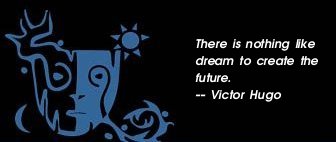|

Follow Your Own Path:
An Interview with Jerry Wennstrom
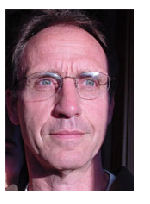
By Brenda Sutton
Publisher's Note: Jerry Wennstrom entered our Mythic radar by way of the serendipitous actions of
several friends (including the former editor of
Parabola, Joe Kulin, and Jerry's wife, singer and ceremonialist, Marilyn Strong).
Meeting this good man has been like reconnecting with a long lost pal from another planet. Jerry has traveled an arduous road to
serve as the contemplative conduit for many a Muse. He peers through fractal lenses at the material and spiritual worlds,
translating visions from the sideways glance.
So, if you've not read
The Inspired Heart: An Artist's Journey of Transformation or the book about his life
Holy Personal by Laura Chester, or seen Parabola's documentary film called
In the Hands of Alchemy: The Art and Life of Jerry Wennstrom, then here is
an introduction. Mythic community, meet Jerry Wennstrom.
Brenda — The artist's path is rarely an easy road. At the ripe old age of 29, you chose to roughen the track by destroying
all of your art, giving away all of your possessions, and living a life of simplicity. You ate when you had food and fasted when you didn't.
You observed 15 years of celibacy until meeting your life partner, Marilyn Strong. An outside observer, watching you leap off the well-traveled
road and plunge into the thicket, might think that your choice defied all rational approaches towards balance and peace. And yet, you've managed
to not only achieve a life of inner poise and calm, but to thrive when so many other conventional artists flounder. What events in your
life prompted your inspirational decision? What was your turning point?
Jerry — There were many whispers along the way pointing to this metaphoric plunge "into the thicket" as you put it.
I was extremely driven as a young artist and had produced an enormous body of work by the time I was 29. It was at this point that I began
to feel art, as I had known it, had taken me as far as it possibly could. Ramakrishna says, "When you take a boat across the river, you don't
take it with you once you've reached the other side." Painting in the studio served that leg of the journey and became too small a vehicle
to carry the larger creation I sensed was moving in me. With the discomfort of this realization stirring in my inner life, I knew I needed to
give my full attention to the process. Fasting helped direct this attention, so I fasted for as long as it took for me to see what life was
asking of me. I had no idea that the final expression of this focus would be to destroy my art and give everything I owned away.
After a month-long fast, two choices became clear to me. I could keep doing what I was doing and remain in the safety of the known
and acceptable form of the conventional artist, or I could give myself to the formless allurement I was sensing would transform my life.
Making this decision was not based on reason, so there was not the rational scenario guaranteeing some identifiable, beneficial outcome.
As you stated in your question, an outside observer would not think the decision rational, and it wasn't—it was intuitive. I knew if I were
to continue along a path of heart, the only thing to do was to find courage enough to let go of my identity as an artist and completely
give myself to the formless, allurement I sensed was drawing me forth.
It is mostly in retrospect that the true gift of that choice has revealed itself to me. My idealistic dream as a budding young artist was
to touch the world with my art in some significant way. I find it a bit ironic and something of a cosmic joke that I have been acknowledged
more for having destroyed my art than I ever was for creating it! Included in this acknowledgement were a Parabola documentary
film that was made about my life and art, a book I was asked to write, (by my now, publisher) and the new Sentient Publications DVD
"Studio Dialogue," which is a presentation of my work before a live audience.
The paradox of letting everything go and the mystery of its return express the deeper meaning of the word 'sacrifice.' A word that literally
means 'to make sacred.' When we can trust the quiet calling of our hearts and lay our hopes, dreams and precious attachments on the altar
with a willingness to let them go forever, then the whole of our beloved creation will be sanctified and returned to us in ways we never would
have imagined!
Brenda — Who or what sustained you along this self-made obstacle course? And how did that sustenance manifest?
Jerry — I don't see it as "self made." I was a willing and, at times, hesitant participant in something moving through
my life. This "something" was larger than the size of the "self" it would have required to self-make anything, outside of the events that
unfolded. However, once I gave myself to the process, what sustained me were, in a word, Miracles! — I never would have been
able to live this strange and lonely journey if the unseen hand of grace did not uphold my journey. This grace was not the product of my
will, intelligence or good intentions. Instead, it came in surrender, when I was able to let go and take one more step in the direction of the
emptiness that I feared might swallow me up. There was something about my willingness to let everything go and take that step, that left
me in the position to call on this grace and really mean it. When all else failed my simple invocation was, God—I have given it all—you
have to help me.
I will share a short miracle story from my book—
Bread for the Journey
I was often hungry. I was learning trust, and hunger was my relentless teacher at that time. Sometimes my hunger became larger
than I could bear. One rainy day, on such an occasion, I walked by a funeral home. I often walked by this particular funeral home on my
way to the library. As I passed by, I looked in and saw a funeral going on. I thought, "How much easier it would have been to die, to just
leave the earth like Christ did." I knew that what I had walked into looked like death, and everything that my life had been about was gone,
but I was still here, hungry! How would I eat and take care of myself and find God too? Just as I had that thought, I looked down in front
of me and saw a soggy twenty-dollar bill floating by in the gutter. I was fed that day and every other day the gods chose to feed me, and
when they did not, I did not eat.
Brenda — Did you ever reach the point where you were ready to chuck the chucking, and return to your
former existence?
Jerry — Of course I had my doubts and still do, at times, but that doesn't stop me from staying on track with the
gift of the original inspiration. It is the power of this inspiration, and more importantly, the leap itself that sustains the journey—not
my fragile position of confidence or doubt. I know it is difficult for many people to understand, but once I gave myself to such a radical act
of surrender, I didn't feel I had the option to entertain the doubts that came up for me. Inspiration has a way of "making us a deal that
we can't refuse"—and many of us have had this experience. Once I was inspired to make the initial leap into the metaphorical death
experience, there was nowhere to go except, perhaps, back into the collective paradigm of fear, control and limitation. What kind of salvation
could that choice have offered?
There are no reference points when we no longer take our cues from collective reality and begin to trust our one-on-one relationship
with the mystery. It is, without a doubt, difficult holding the unknowing of such a path, but it is an unavoidable requirement of the journey.
When one has been empowered to move forward, in a radical new direction, there is a loneliness and responsibility that simply comes with
the territory. However, with any personal breakthrough that inspires us to move forward, in spite of our doubts and fears, comes the ineffable
knowing that the new ground where we stand is Real and therefore, self-sustaining. The luxury of doubt becomes a ridiculous non-option in
the face of this knowing.
There actually were times when I would try to indulge in self-pity just to give myself a rest and hopefully make the world real again. But
because of what I knew, I could never quite feel like I was a victim of anything. I was more alive—scared at times, but more alive—so
I would end up laughing at myself. It is like jumping overboard, knowing the buoyancy of water but not knowing how to swim. You simply
have to trust what you know about water, that it will do its part to uphold you as you give your all to mastering a strange, new environment
and figuring out how to swim about freely.
Brenda — In your book, The Inspired Heart: An Artist's Journey of Transformation, you said, "I was
inspired by the lives of many great souls about whom I had read, and this helped me. I found courage enough in their stories to initiate and
fully accept the challenge of my own calling. However, I did not know their gods; I had only just met my own. I knew very little about how
to communicate with these gods or where the communication would take me. I trusted a higher good that I sensed was much better equipped
to inform my choices than anything I had available in the limited range of will and intelligence." Please describe your current relationship
to that "higher good."
Jerry — It is essentially the same as it was when I made the original leap and decided to trust life as it came. However,
over time the process has become more natural and easier as a total way of being. What starts out as a passionate quest or discipline eventually
becomes second nature if we are able to trust and stay with it. It is like learning to dance—at first, accepting the form and placing your
feet in the prescribed places on the floor seem awkward and meaningless. Eventually, the steps and movements become embodied. We feel
the music and eventually the spirit, and the music and the body become gracefully one.
One's relationship with "higher good" becomes more refined, yet it continues to reflect something of the original steps learned. In later life,
we must remain vigilant and maintain the humble requirements of the dance. However, the eventual blending of divergent elements and the
meaning that comes with the blending, takes on a form that becomes our personal, celebratory dance.
Brenda — How has your life changed in the past 20 years?
Jerry — In retrospect, I feel I have been given a gift and a blessing that I may or may not have deserved. Twenty years
later, the gift continues to deliver and evolve in ways that have to do more with my current life. With this gift, I continue to experience renewal
in the cyclical return of something that resembles the original experience of death, defeat and surrender. However, I do so now more willingly.
Yogananda poetically alluded to this paradox
when he said, "To set out on any holy purpose and to 'die' along the way is to succeed." Life for me now is the product of that sacred wounding
and holy defeat and it is also my joy, my gift and my success.
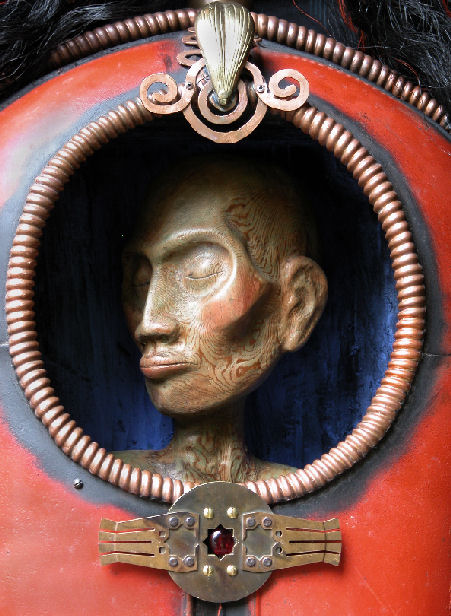
The Sacred Wound (Detail)
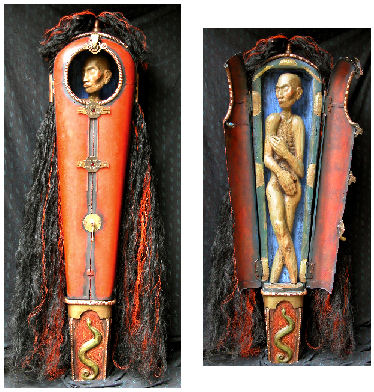
The Sacred Wound (Closed) — The Sacred Wound (Open)
Brenda — If you hadn't chosen the route that you took, where do you imagine that your path might have taken you?
Jerry —I'll give you my "pat answer". There is no such thing as
If there is only What Is! Having said that, I can imagine nothing would have happened—the kind of boring nothing that
comes with intelligently and strategically playing it safe our whole lives. If the template had not been struck with the initial leap of faith that launched
my journey, I probably would have needed to create a self-deceptive illusion for myself to survive the fact that I sold my soul down the river to a
lesser dream. I would then have had to quietly accept my fate and settle-in among the living dead — probably in the suburbs where I could paint
on Sundays and water my perfect (but toxic) lawn to remind me of something resembling life.
Brenda — Please talk about the lessons learned from denying the demands of the body?
Do they compare with the demands of spirit?
Jerry — When we turn away from the demands of the body we discover the spirit has been tracking all along. We discover
that most of what we think we have been doing to sensibly meet the demands of our lives (which are mostly demands of the body) has not been
much more than busy-work. Ultimately, we discover that spirit runs the show and our deepest encounters with the mystery have a way of altering
the body, mind and spirit.
At some level, I feel I did not choose to deny the demands of the body. Fasting, celibacy and the long periods of silence seemed to have chosen
me as I surrendered more and more to the requirements of the strange life I had given myself to. In the process of turning inward to that which felt
most real and beautiful, and facing every fear as it came up naturally, I arrived at these ascetic disciplines. They were unexpected teachers and taught
me things I never could have learned any other way.
I was familiar with fasting — I had done it once a week for about ten years. I began fasting as a "cleansing" when I was 20 years old.
It was a spiritual discipline suggested in a book that I had read at the time. I later discovered fasting increased my perception and helped my art so
I continued doing it once a week. After destroying my art, giving everything I owned away and deciding to trust life to provide, it was no longer a
"discipline." I fasted because I didn't have food.
Fasting taught me how to find nourishment in an inspired moment and to trust and act on my intuition. It taught me the importance of right
timing. It taught me about places and moments of real power that nurture the soul, which then nurtured the body. There is nothing more insistent
than hunger and the primal instinct of the mind bent on survival to set one off in the direction of the "barn", so fasting taught me the fierce discipline
of trust under any circumstances.
Celibacy taught me how to redirect my sexual energies and how to hold and become my own feminine and not project it onto every illusory
attraction that promised comfort and fulfillment. It taught me to easily remain present with others, especially women, and to enter into the heart
of communication without an agenda or the interference and confusion of personal desire.
Silence taught me how to see the perfection of reality—just the way it was. It taught me how to allow the perfection of each moment
to carry itself without my interference.
Like many of us, I feared the void, which I also experienced in a literal way by denying the body. By ignoring the clamoring of my own physicality
and facing the fears that came up, I discovered that reality is larger than the perceived limitations of the body and mind. I also learned how to allow
nourishment to come through at all levels, on its own terms. Sometimes it would be a glance; sometimes it would be a purely energetic experience,
and sometimes it actually would come in a physical form. What I ultimately learned from the discipline of restraint is that the universe provides in
unimaginable ways. The beauty of the human experience is to become a willing and grateful participant in the natural flow of this providence.
Brenda — You continue to create art with objects that you find or that are sent to you.
You're considered to be a very fine storyteller, as well. Do you merge your stories with your art? Does the art express its own story?
Jerry — I feel art and story would have to exist and emerge simultaneously if the creation was to express anything of our larger
collective myth. To quote Novalis, "The seat of the soul is there,
where the outer and the inner worlds meet." If the ego of the artist gets too involved and these things begin to separate, where the artist attempts
to fit story into art or art into story—all is lost! Instead of being art it becomes what Joseph Campbell describes as propaganda.
By "story" I am assuming that you mean myth. To be a "fine storyteller" one would have to somehow access and deliver the myth underlying the
story. The timing of a story (when and where it is told) also counts in the overall economy of the tale, if it is to effectively resonate in the hearts of
others. The essence of story/myth takes on different forms and expresses itself in many ways and certainly art is one of the powerful ways it does this.
Story, as a means of communication comes naturally to me. I have always had a useful story to tell those who come to me for help or support,
or in relation to the themes of the public events I do. The stories I tell are essentially transpersonal in nature, yet they come from my own experience.
They are made more personal when told with an intuitive sense of service to the person or people I happen to be speaking with. My book came out of
the deeper mythos of my story/journey and perhaps illustrates best, the way in which story, art and life can consciously merge and emerge.
Mythos is alive and well in most of us and we are able to glimpse or experience the mythic element in art, even if we do not do so
consciously. We feel something and are inspired in some way that may not be rational. However, to access and express our own personal mythology
directly, we must first live it out in the loneliness of our one-on-one relationship with our god. Once it has been lived, the mythic nature of our own
true story makes its way into the world as an expression. It begins to resonate with others and serve as a reminder to those who have lost sight
of their own personal myth. Sadly, most of us are not willing to venture too far into this territory on our own. Instead, we add an insignificant,
personal touch to the homogeneous story already being told by our generation.
In my own process, story merges with my artwork as it unfolds and I feel I have little to do with how it actually does that. It is complete only as
the deeper meaning is revealed. It is like the dream that occasionally crosses over into reality and affects our daily lives. The art/story I share with
the world is only as real or significant as that which I have received in this crossover. Reverence and wonder are probably as much as an artist can bring
to the actual mystery of this process.
I will share a story from my book that illustrates how art and story merged for me in an interesting way.
Lucy
 I was helping Jeanine, a friend from Seattle, move from a large apartment into a small, older house she had finally managed to purchase with her
hard-earned savings. I came into town with my old pickup to help transport her belongings. With my small truck and a mid-size rental truck, we managed
the move in one trip. As we unloaded the contents of the rental truck into her much smaller abode, the house began to fill up with too many items.
At one point, in spite of several attempts to rearrange things, it became apparent that the furniture was too much for the house and some of it
would have to go. At one point, Jeanine said, "Jerry what's left in your truck?" I listed the few things that remained, including an oak cabinet that
was six feet high, very narrow (ten inches or so), and about ten inches deep. It was an unusual old piece with small shelves, three inches apart,
running its entire length. Well-used and ink-stained, it appeared to be something out of an old post office. When I mentioned this piece to Jeanine
she said, "Oh, that thing! Do you want it?"
I was helping Jeanine, a friend from Seattle, move from a large apartment into a small, older house she had finally managed to purchase with her
hard-earned savings. I came into town with my old pickup to help transport her belongings. With my small truck and a mid-size rental truck, we managed
the move in one trip. As we unloaded the contents of the rental truck into her much smaller abode, the house began to fill up with too many items.
At one point, in spite of several attempts to rearrange things, it became apparent that the furniture was too much for the house and some of it
would have to go. At one point, Jeanine said, "Jerry what's left in your truck?" I listed the few things that remained, including an oak cabinet that
was six feet high, very narrow (ten inches or so), and about ten inches deep. It was an unusual old piece with small shelves, three inches apart,
running its entire length. Well-used and ink-stained, it appeared to be something out of an old post office. When I mentioned this piece to Jeanine
she said, "Oh, that thing! Do you want it?"
Actually, when I had first loaded it into the truck, I had liked it very much. The fact that it was irregular and poorly made appealed to me, and I
fantasized about the art piece I could create out of it. When Jeanine asked if I wanted it, I thought her offer was pure magic! I said, "Sure, I know
just what I will do with it." I began work on the piece the very next day.
The overall plan was to remove the shelves and then make a tall, narrow, primitive figure out of a slab of old cedar to fit inside the cabinet.
The figure would have two images, front and back, that could be changed by turning a brass ball on top of the box. I thought I would create
two very different images, opposite in nature. I wanted the figure on one side to be masculine, dark, and mysterious. I wanted the other one
to be feminine, inwardly focused, and expressing something vast, innocent, and light. I began creating the dark side of the figure first.
In the cedar grove on our land, I looked for an interesting, rotted piece of wood that I had taken note of previously. I vaguely remembered
seeing it lying, covered with moss, near the sweat lodge that I had built a few years earlier. I noticed it because it was roughly the shape of a
human figure. Cedar sitting on the damp forest floor can remain relatively well preserved for fifty years or more under the right conditions. Just
under the rotted surface of a slab of fallen cedar, beautiful, well-seasoned wood can remain intact.
When I found what I was looking for, I carved the cedar to enhance the already rough human shape of the slab. I was careful to include
the rotted section of the slab. The wood soon became a simple, stylized human form. The rotted wood gave the figure the feel of an ancient
artifact. As the face appeared, it became predatory and bird-like. Just that week a friend had given me a newly killed hawk that he had found
dead on the side of the road. For the nose, I used a combination of the hawk's beak and pieces of tarnished old copper from an antique toilet
tank I had found at the dump. I made the hands for the figure from a pair of owl's talons that I found at our local thrift store. They had been
placed neatly in a cotton-lined plastic box and labeled "Owl." Owl medicine, I have been told, represents death medicine in certain Native American
traditions.
Next I gathered bones. Two years earlier, I had buried a coyote that I found dead on the side of the road. I dug up the bones that remained
to use in the piece. With the bones and some discolored, old hemp twine, I created a skeletal-like body. In the heart area, I mounted the coyote
pelvis. The pelvis of a coyote looks very similar to a small skull or a human face. Just above the pelvis, and running through the "face," I hung the
braid that a friend had given me after cutting her long hair a few months before. Finally, on the little face, I hung a beautiful petrified shark's tooth.
My ten-year-old friend, Mercia, had found the tooth on a beach in Florida and had given it to me as a birthday gift that year. With the dark and
mysterious side of the figure complete, I was ready to work in the light of its counterpart.
 Our beloved friend Lucy is one of the most extraordinary children I know. At the time, Lucy was eight years old and could easily light up a room
with her presence. As I was deciding on a face for the light-filled side of the piece, Lucy immediately came to mind. At the time, Lucy had been sick
with pneumonia for quite a while, so I went to visit her. I brought her some gifts and spent the afternoon with her. When I arrived that day, she was
working on a school project. The assignment was to dissect several owl pellets, or droppings, and label what she discovered in each pellet. She showed
me that she had glued the recognizable elements on a sheet of paper with the appropriate labels. The remains of the owl's last meal consisted of hair,
teeth, and bone. I was interested in how similar the components were to those I had just incorporated into the new art piece.
Our beloved friend Lucy is one of the most extraordinary children I know. At the time, Lucy was eight years old and could easily light up a room
with her presence. As I was deciding on a face for the light-filled side of the piece, Lucy immediately came to mind. At the time, Lucy had been sick
with pneumonia for quite a while, so I went to visit her. I brought her some gifts and spent the afternoon with her. When I arrived that day, she was
working on a school project. The assignment was to dissect several owl pellets, or droppings, and label what she discovered in each pellet. She showed
me that she had glued the recognizable elements on a sheet of paper with the appropriate labels. The remains of the owl's last meal consisted of hair,
teeth, and bone. I was interested in how similar the components were to those I had just incorporated into the new art piece.
I asked Lucy about making a mold of her face to include in my piece. She was excited by the idea, and we decided to make masks together.
I completed the molded mask of her face and then plated it with copper and installed it onto the figure. Lucy's face with its mysterious inner light,
now glowing in copper, was further adorned with carved wood and fabricated metal. In the heart and lung area of the figure, I added a carved lotus
flower, which completed the light body.
Lucy's pneumonia was staying with her longer than it should have. About the time the art piece was done, her parents decided to bring Lucy
to a Seattle children's hospital for a more thorough examination. We were all concerned when the doctors found something unusual in the area of
her lungs, which they called a teratoma. A teratoma is a tumor that might have begun early on in the womb as a potential twin. Within its mass,
teeth, hair, and bone could develop. Removal of the teratoma required surgery, which is finally what was decided on.
Lucy was fearless as she approached the surgery, and just prior to it, she had some questions about the nature of the teratoma. She knew
that it might have been nature's attempt to create a twin and that it might contain hair, teeth, and bone, just as a real person would. In her young
mind, she imagined a tiny person locked inside her body, one that might look just like her! Just before her surgery, she asked sweetly, "Does it have
a face?" When I heard this, I thought of the coyote pelvis that looked like a little face. It was in the same area of the art piece as the tumor was in
Lucy's body.
Lucy's operation was a complete success. She was out of the hospital and home in just a few days. She was out bouncing on her trampoline
and playing soccer within the month!
Brenda — Has your path been one that you would recommend to others? If so, why? And if not, why not?
Jerry — I wouldn't recommend my path to anyone else—at least not the particulars of my path. Each of us must find
our own way within the existing structure of our lives. I have met the requirements of an archetypal journey that, in essence, belongs to all of us; yet,
the story unfolds differently for each of us. There are elements of my journey that are universal and might translate or be useful to others. I think of
my path as the hard-earned territory I have bushwhacked, mostly out of my own personal quest for meaning. Hopefully, others inspired by my journey will
experience something of the gift inherent in the ground I have established for myself. The gift is poetic in nature and offers a way of seeing and
investing in something that delivers by way of paradox. The deeper mythology of another's path can inspire others.
Brenda — I grew up on
Whidbey Island in the Puget Sound, so I'm very familiar
with the astonishing beauty of the place where you've centered your home. It's about as far-removed from your New York origins as one could get.
How did you come there? And could you have explored your path had you remained a painter in the big city?
Jerry — Coming to Whidbey Island was my return to the world in a sense. It was the downhill side of the adventure,
where the things of the earth began coming back to me. I believe I would have explored my path wherever I was because I did not choose
one place over another during my 10-years sojourn (and another 3 settling on Whidbey Island.) I gave everything I owned away so the option
of choosing one place over another was not part of my thinking—at least it was not a part I had any control over. I lived in the moment
and went where I felt called. I write about this in my book, part of which I will share with you here.
A Return to the New (an excerpt)
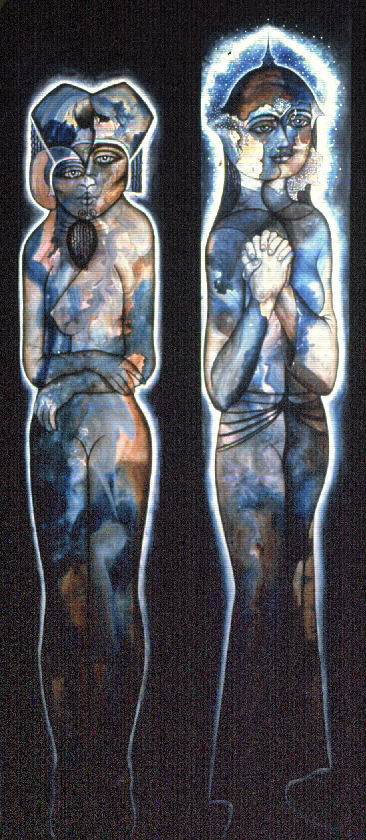 My arrival on the west coast was a homecoming in many ways. What New Yorkers saw as my strange inner life (and it was strange even
to me) was fully accepted and honored by the community in which I now found myself. My spiritual journey had made its way full circle, in the
manner that only years of soul seasoning and Grace can bring.
My arrival on the west coast was a homecoming in many ways. What New Yorkers saw as my strange inner life (and it was strange even
to me) was fully accepted and honored by the community in which I now found myself. My spiritual journey had made its way full circle, in the
manner that only years of soul seasoning and Grace can bring.
I received a deep imprint of practical, useful understanding from the demanding requirements of constant surrender. It was a total-body
memory, like a ritual scar. The gifts and stories I acquired from this sacred wound were my compassionate offerings to others who were in pain
or confusion. I offered this freely as potentially useful information, as reference points to be used at the difficult impasses of their own spiritual
journeys.
I gladly left behind the once necessary extremes of learning to surrender. I also left behind the years of constant, fierce attention to the
return to zero. I had lived this zero so completely that when I first came to Whidbey Island and fell in love with this magical land, I thought that
I would not be able to hold on and stay here. I moved here with no money; the contents of a small backpack were my only possessions. That
was how I had lived on the east coast, but there were new and strange gods in this Northwest—gods I didn't know by name.
I got very sick shortly after arriving here. In my fevered condition, I felt that physical reality was once again slipping away. I was sure that
I would have to leave this land too, as I had left everything else I loved in my life. In quiet despair, I walked out into the rainy, cold, northwest
autumn to visit a particular place of beauty for what I thought was the last time. I had felt a strong connection to this place right from the beginning.
I hoped that perhaps this special place would recognize me as one of its own, as one who had bowed in awe to its majesty. I wanted Whidbey
Island to reach out an unseen, loving hand and hold me down here in the place I most wanted to be.
I stood on a wall, looking into the fog and the water. A narrow culvert ran through the cement wall, carrying fresh water into the salt of
the Puget Sound. It would have been an impossible opening for any salmon to negotiate, yet as I watched, one lone salmon tried. The fish
looked so battered by its determined effort to get up into that little culvert. My heart went out to the creature, but I also felt my own self-pity.
I climbed down the wall, closer to where this dramatic spawning ritual was being lived out, as I imagined it had for thousands of years in many
more natural places. The human construction of concrete and steel the fish was attacking was probably what had caused it to lose sight in one
of its eyes. I wondered what was blinding me and keeping me from seeing what I was supposed to do. 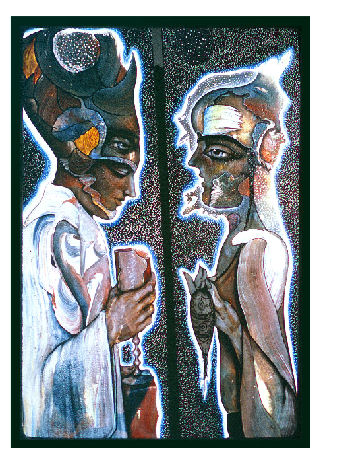 What unnatural thing was I beating my
head against, and what impossibly small space was I determined to inhabit, against the current of the ocean that presently held my life? I walked
around to the eyeless side of my exhausted teacher. Carefully reaching out, I stroked its back gently with my finger, and wished it well, hoping
that God would do the same for me. What unnatural thing was I beating my
head against, and what impossibly small space was I determined to inhabit, against the current of the ocean that presently held my life? I walked
around to the eyeless side of my exhausted teacher. Carefully reaching out, I stroked its back gently with my finger, and wished it well, hoping
that God would do the same for me.
Nuns from a Dominican Convent had given me a purse in the shape of a fish that was full of cash. Money from the belly of a fish had carried
me over the United States, and now I stood, solid and safe, with both feet in the territory of the new life. But I felt the powerful imprint, in my
trained, obedient consciousness, of living for so long in the gravitational pull toward zero. In retrospect, I know that I was returning to the world.
My life among the fixed and living creatures of the planet was unfolding. From the point of my arrival on Whidbey Island, I could manifest physical
reality and it would hold. My arrival in the Northwest was the center point, the moment where the slack tide is completely still and begins to
return its abundant waters. At the moment of stillness, there was no clear indication of what I should do. Should I give space to receiving the
incoming tide or follow it out and participate fully in its empty leave-taking? I wanted to give myself to the direction of the powerful, inevitable
forces at work here, but slack tide is like a moment in which we can see with only one eye. With that one eye we see, without knowing, the
present inactivity of omnipotent forces that might have just decided on the gift of abundance.
Opening up to a returning world required a readjustment. I had to readjust my wild sacrificial ways to the gentle demands of a new, kinder
god. Perhaps this was a generous, abundant Northwest god of the reliable salmon people, a God who did not constantly demand his pound of fish.
This god had plenty. In this land, fish with bellies full of gifts might quite possibly be the rule rather than the exception. Life here might not
require the sacrifice and prayers of gentle nuns mixing potions of love and money. It might not need cloistered virgins to empower symbols of
abundance in the shape of a fish, placed first on a Christian altar and then given second hand to a hungry, formless man. And it might not ask
men to become as dangerous to solid matter as the formless black holes in space are to stars.
I was starting a new life in a new land with a newly unfolding story. In this territory, the holy willingness to let things go seemed to bless
them and gently, yet solidly, reposition them in life. Somehow, the very real, internal ritual of the sacrifice of what I desired from this world was
enough to sanctify the dream of matter and bring it to life. Through detachment, dreams placed on the altar could exist in reality.
As I write this, fifteen years later, I thank the gentle, deeply feminine spirit of the earth for making the world of matter a beautiful human
experience. I believe that our essential willingness to sacrifice matter for spirit is an expression of the masculine element of our being. Our mother,
earth, is feminine, and far more generous and forgiving.
Brenda — You have no regrets about having destroyed the art of your early years.
All that's left of it are some photos recently resurrected by a friend. Do any of those images continue to work their way into your current
creations?
Jerry — I have no regrets. This has been an amazing adventure for me and I believe it continues to be a gift to others
who find inspiration enough in my story to trust their adventures. I must, however, say—being young and idealistic when I set out to be
an artist—if I knew what I was getting into, without seeing the unexpected ways the journey has carried my life, I might not have set
out on the journey in the first place! I can only thank the gods for the inspiration that set the path in motion for me and for the ways in which
the fool's journey is blessed.
In seeing the journey in retrospect, and from working closely with others on the path, I can say, with absolute certainty, that any path
we bring all of our heart and soul to will lead to some final expression in death and resurrection. There is simply no way around it. To think we
can succeed, in the most complete sense of the word, without the holy defeat is the worst folly.
There continues to be something in the spirit of the destroyed paintings that does find its way into my current work. Take for example,
the duality expressed in the images I was painting in the late 70s, just before destroying my work. They were painted Beings, one
on each side of the canvas that expressed the opposites. Hung in groups of 10, each by a single cord, the figures slowly spun—changing
from light to dark, they seemed to relate to each other. I continue to work with duality in my current work, however, as a young artist,
painting in the studio, I didn't just paint the opposites; I was the opposites! Painting in the studio, I unconsciously sought completion
in my exploration. Now, for me, it is quite different. I have been gifted with the resolve of those opposites, which ultimately had little to do
with what I thought I was doing at the time.
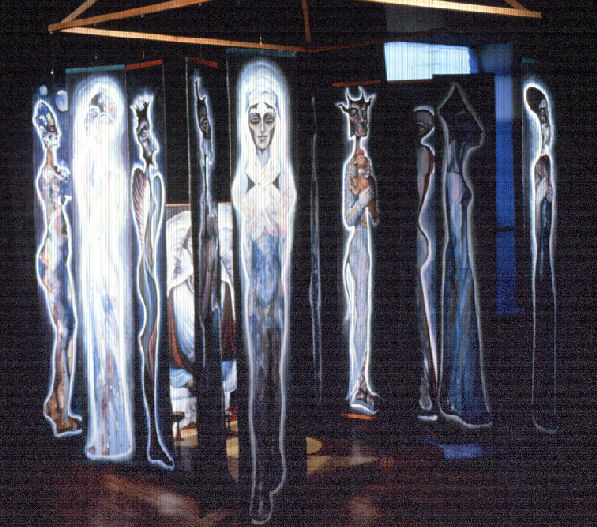
"Mythic Series" 2-sided Panels Turning
Brenda — What are the most important metaphors in and for your life?
Jerry — Many of the important metaphors have been expressed in this interview—death/life, sacrifice, inspiration, mystery, paradox and
wholeness, inherent innocence, the metaphor of an intuitive leap...the word itself is an important metaphor. A glimpse into the sacred, ineffable
spirit of the journey can be only faintly expressed or perceived through the use of words. Perhaps at a deeper level we get a better glimpse
through the intuitions and epiphanies that come to us in a flash. Most importantly, we see most of what we need to see through the haze of
our tears. And that's the last metaphor.
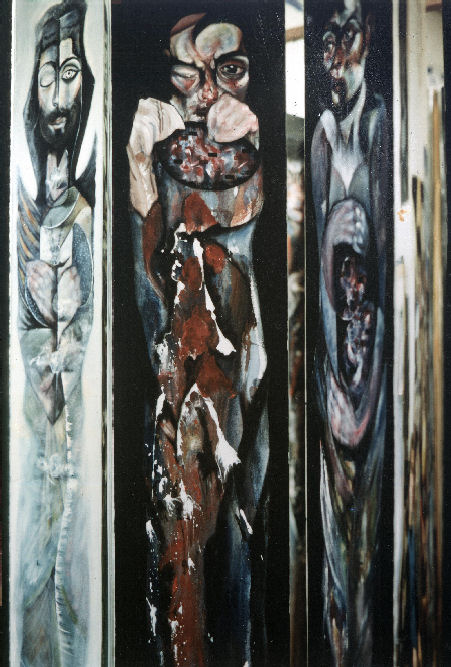
"Angel and Demon" Series - 2-sided Panels Turning
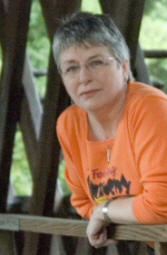 Brenda Sutton is the publisher of Mythic Passages, Operations Director, Corporate Secretary, and Office Administrator for Mythic Imagination Institute. She is an award-winning singer/songwriter with the internationally reknown band Three Weird Sisters. She works in a support and consultant capacity for the non-profit music organization Interfilk, and maintains their website. She is freelance writer whose work has appeared in newspapers and magazines. She is also the mother of five, grandmother of two.
Brenda Sutton is the publisher of Mythic Passages, Operations Director, Corporate Secretary, and Office Administrator for Mythic Imagination Institute. She is an award-winning singer/songwriter with the internationally reknown band Three Weird Sisters. She works in a support and consultant capacity for the non-profit music organization Interfilk, and maintains their website. She is freelance writer whose work has appeared in newspapers and magazines. She is also the mother of five, grandmother of two.
More on "Courage":
To read more of Jerry Wennstrom
and view his paintings and sculpture please visit his website
handsofalchemy.com
Return to Mythic Passages Menu
Subscribe to the Mythic Passages e-magazine
|
